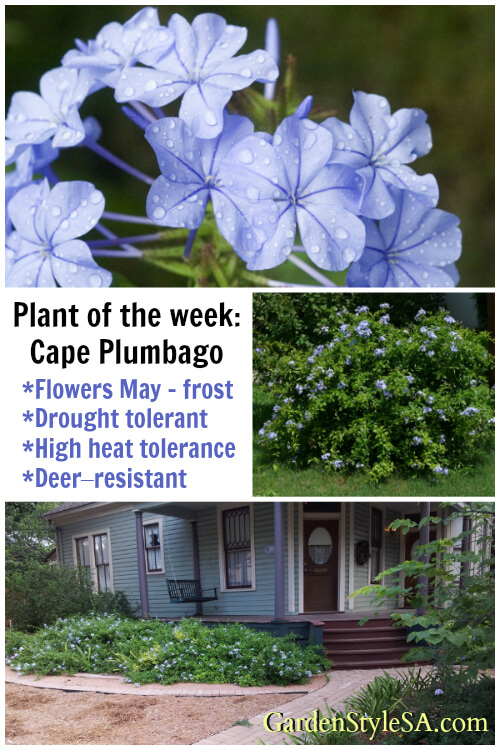Cape Plumbago – Cool Color for High Heat Landscapes
As most gardeners know, there is a season for everything… especially plants. With that in mind our plant of the week section will help us share information on the best plants to consider adding to your landscape that will thrive in each season. If you live in South Texas you know that our landscapes have to survive intense heat and this week we are talking about one of my favorites, cape plumbago, or plumbago as it’s better known.
During the heat of July, the soft pastel blue of the plumbago flowers helps to visually cool our spaces. But don’t let the delicate flowers fool you, the plumbago maintains the inner physique of a South Texas cactus and is able to withstand the searing South Texas summers once established.

Plumbago Attributes:
As hinted at by its name, the “cape” plumbago is originally from South Africa. This is a non-native I can get behind because the species does not appear to be invading our homes, parks or natural areas. A plumbago plant can grow 3 to 4 feet tall and span a width of up to 5 feet. It thrives in full sun and well-drained soil. Plumbago blooms on new growth so the primary pruning should take place in early spring and you should gently prune as needed through the growing season to maintain its health and shape. If spaced correctly the shape of the shrub will be that of a cascading fountain.
Leadwort, a cousin of the cape plumbago, also known as dwarf plumbago can be used as low-growing groundcover. While it too is non-native like standard plumbago it is not invasive and still recommended for our landscapes. Plumbago in general is coveted not only as a shrub but can also be trained as a climber or grown in pots. As I mentioned before, this is a tough plant, surviving both sun and partial shade, although you should note that the more shade it gets the less flowers it will give you.
In our environment another key feature of this plant is that it’s, deer-resistant. Because if it can survive millions of antelope, wildebeest and buffalo, it can certainly face down our small local deer. Really plumbago’s only downside is that it is just semi-evergreen. During cold winters plumbago will lose its leaves; however, it will return robust and vibrant in March. Plumbago plants flower from May to November (or up to the first frost).
When to Plant Plumbago:
Add this shrub to a sunny spot in your yard November through March. If it is not in your landscape now in mid-July I’m not suggesting you add it but given how well it handles our climate and how much color it can provide, I suggest you start planning now so you can add it to your landscape in the fall. Visit our WaterSaver Lane for more inspiration.
Key Facts:
- Sun Preference: will do well in either sun or partial shade. My experience is that plumbago does best with late afternoon shade.
- Spacing: 3 to 3 ½ foot spacing
- Mature Height: 3-4 feet tall, 4-5 feet wide
- Watering: after establishment, water deeply (3/4 inch) twice a month
- Pruning: once in early March and once in late August. Prune ½ of the plant in early spring and ¼ of the plant in late summer.
- Fertilizer: never
- Pests: only humans




